
L-R: Chew Leng Soon, Tay Seok Hooi, Bernard Lee, Ching Neng Bin at Confucius Six Arts City (Qufu 曲阜).
Day 11 (09.12.2011) Taian 泰安 (Shandong) day trip to Qufu 曲阜
Breakfast in our room with coffee and bread. We had hot soya bean milk at KFC and walked to the bus stand and took the local bus to the bus station at the foot of Mt. Taishan. We were told that there was a road repair work in progress and buses are not going up until further notice. We then decided to visit the City of Qufu 曲阜 the birth place of Confucius.
We used the service of the private vehicle to take us there that cost us RMB300 for the day. Visited Confucius Six Arts City (Liu Yi Cheng) first and had lunch (Y280) at a local restaurant. We then visit Qufu Confucius Temple (Kong Miao) and Confucius Family Mansion (Kong Fu).
Temperature: -10°C (min) and 3°C (max)
Accommodation: Taishan International Youth Hostel (Y130 a room for two)
We used the service of the private vehicle to take us there that cost us RMB300 for the day. Visited Confucius Six Arts City (Liu Yi Cheng) first and had lunch (Y280) at a local restaurant. We then visit Qufu Confucius Temple (Kong Miao) and Confucius Family Mansion (Kong Fu).
Temperature: -10°C (min) and 3°C (max)
Accommodation: Taishan International Youth Hostel (Y130 a room for two)

Breakfast in our Taishan International Youth Hostel room with coffee and bread.
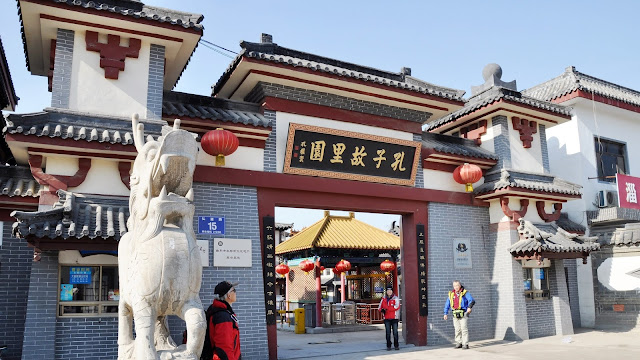
At the main entrance of the Confucius Six Arts City (Liu Yi Cheng) Qufu 曲阜.

Confucius Six Arts City (also called Confucius’s Six Classical Arts Hall), located at No.15, Chunqiu Road, Nanxin District, Qufu City, is a theme park displaying the thought, teaching and life of Confucius (551-479BC) (an ideologist and educator in ancient China, and the great founder of Confucianism) and the folk culture of ancient Lu State. It is so named, because the six arts (ritual, music, archery, driving, calligraphy and mathematics) were advocated and taught by the sage.

The map of Confucius Six Arts City (Liu Yi Cheng) Qufu 曲阜. Recommended travel route: Confucius Square – the Bronze Statue of Confucius’ Visiting to Many States - Ritual Hall - Calligraphy Hall - Driving Hall - Archery Hall - Music Hall - Mathematics Hall – Yan Music Hall – the Theatre - the Garden.

Inside the Confucius Six Arts City gate is a large bronze sculptures of Confucius.

The scenic spot encompasses an area of 13ha with a distinctive and magnificent architectural complex. Behind it, there is an impressive building – the sphere-shaped Mathematics Hall, where visitors can use all kinds of electronic game machines to solve different mathematics puzzles. The halls of the other five arts surround the Mathematics Hall. Music Hall and Archery Hall are on its left side; Driving Hall and Calligraphy Hall on its right side; the Ritual Hall is at its front. The six arts are shown vividly by employing modern techniques of sound, light and electricity. Following a visit here, tourists will more fully understand the six arts and ancient culture of the Pre-Qin Period.

At the Confucius Six Arts City (Liu Yi Cheng) Qufu 曲阜.

At the Confucius Six Arts City (Liu Yi Cheng) Qufu 曲阜.

At the Confucius Six Arts City (Liu Yi Cheng) Qufu 曲阜.

At the Confucius Six Arts City (Liu Yi Cheng) Qufu 曲阜.

Traveling through time tunnel of 1000 years history in 10 minutes at the Confucius Six Arts City, Qufu 曲阜.
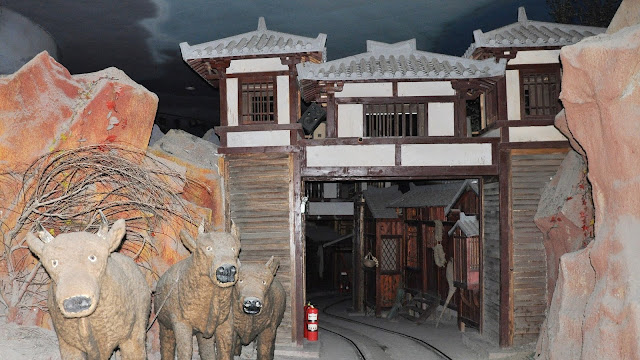
Traveling through time tunnel of 1000 years history in 10 minutes at the Confucius Six Arts City, Qufu 曲阜.

Traveling through time tunnel of 1000 years history in 10 minutes at the Confucius Six Arts City, Qufu 曲阜.

Traveling through time tunnel of 1000 years history in 10 minutes at the Confucius Six Arts City, Qufu 曲阜.

Traveling through time tunnel of 1000 years history in 10 minutes at the Confucius Six Arts City, Qufu 曲阜.

Traveling through time tunnel of 1000 years history in 10 minutes at the Confucius Six Arts City, Qufu 曲阜.

Traveling through time tunnel of 1000 years history in 10 minutes at the Confucius Six Arts City, Qufu 曲阜.

Traveling through time tunnel of 1000 years history in 10 minutes at the Confucius Six Arts City, Qufu 曲阜.

Traveling through time tunnel of 1000 years history in 10 minutes at the Confucius Six Arts City, Qufu 曲阜.

At the Confucius Six Arts City (Liu Yi Cheng) Qufu 曲阜.

The writting on the wall at the Confucius Six Arts City (Qufu 曲阜).

The writting on the wall at the Confucius Six Arts City (Qufu 曲阜).

The writting on the wall at the Confucius Six Arts City (Qufu 曲阜).

At the Confucius Six Arts City (Liu Yi Cheng) Qufu 曲阜.

At the Confucius Six Arts City (Liu Yi Cheng) Qufu 曲阜.

At the Confucius Six Arts City (Liu Yi Cheng) Qufu 曲阜.

At the Confucius Six Arts City (Liu Yi Cheng) Qufu 曲阜.

Calligraphy hall at the Confucius Six Arts City (Qufu 曲阜).

Calligraphy hall at the Confucius Six Arts City (Qufu 曲阜).

A poem was written for Ching Neng Bin using his Chinese name at Confucius Six Arts City (Qufu 曲阜).

A poem was written for Ching Neng Bin using his Chinese name at Confucius Six Arts City (Qufu 曲阜).

A poem was written for Ching Neng Bin using his Chinese name at Confucius Six Arts City (Qufu 曲阜).

A poem was written for Chew Leng Soon using his Chinese name at Confucius Six Arts City (Qufu 曲阜).

A poem was written for Chew Leng Soon using his Chinese name at Confucius Six Arts City (Qufu 曲阜).

A poem was written for Bernard Lee using his Chinese name at Confucius Six Arts City (Qufu 曲阜).

A poem was written for Tay Seok Hooi using his Chinese name at Confucius Six Arts City (Qufu 曲阜).

Confucius Hometown at the Confucius Six Arts City (Liu Yi Cheng) Qufu 曲阜.

Confucius Hometown at the Confucius Six Arts City (Liu Yi Cheng) Qufu 曲阜.

Confucius Hometown at the Confucius Six Arts City (Liu Yi Cheng) Qufu 曲阜.

A large group of bronze sculptures at the Confucius Six Arts City (Liu Yi Cheng) Qufu 曲阜.

A large group of bronze sculptures at the Confucius Six Arts City (Liu Yi Cheng) Qufu 曲阜.

Lingxing Gate (欞星門) at Qufu Confucius Temple (孔廟).

Qufu Confucius Temple (孔廟), at the hometown of Confucius. His ideology was developed to the influential Confucianism, which has had the most enduring and profound effect over Chinese culture.

Qufu Confucius Temple (孔廟), at the hometown of Confucius.
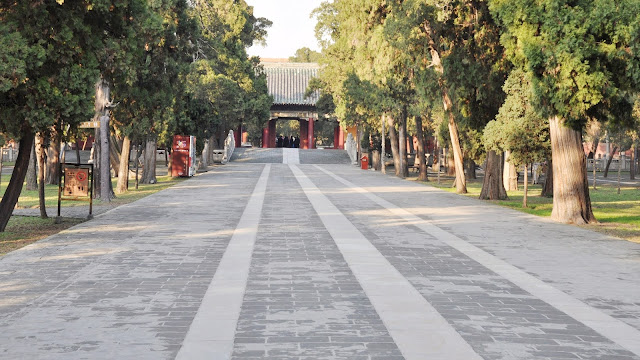
Qufu Confucius Temple (孔廟), at the hometown of Confucius.
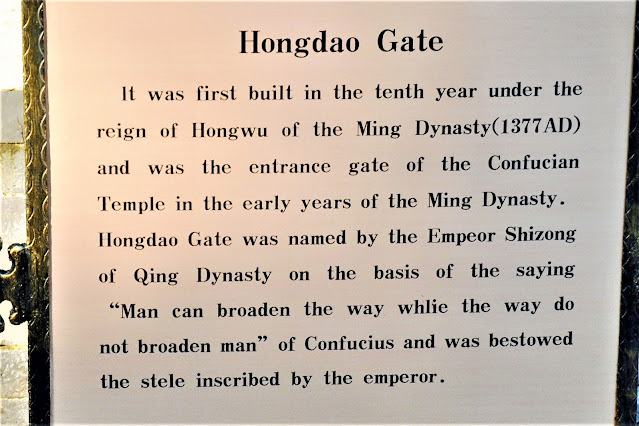
Hongdao Gate (弘道門) at Qufu Confucius Temple (孔廟), Qufu 曲阜.
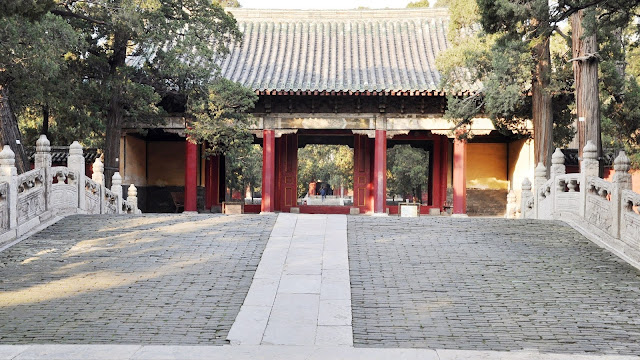
Hongdao Gate (弘道門) at Qufu Confucius Temple (孔廟), Qufu 曲阜.

A number of stone stelae are located at Qufu Confucius Temple (孔廟).

The buildings in the Confucius Temple (孔廟) courtyards form the heart of the complex. They are impressive structures with yellow roof-tiles and red-painted walls, they are surrounded by dark-green pine trees.

Dazhong Gate (大中門) at Qufu Confucius Temple, Qufu 曲阜.

Dazhong Gate (大中門) at Qufu Confucius Temple, Qufu 曲阜.

Xing Tan Pavilion (杏壇, Apricot Platform) at Qufu Confucius Temple, Qufu 曲阜.

In the center of the courtyard in front of Dacheng Hall stands the Xing Tan Pavilion (杏坛 or 杏壇), or the Apricot Platform. It commemorates Confucius teaching his students under an apricot tree. Each year at Qufu and at many other Confucian temples a ceremony is held on September 28 to commemorate Confucius' birthday.

The Dacheng Hall (大成殿), whose name is usually translated as the Hall of Great Perfection or the Hall of Great Achievement, is the architectural center of the present-day complex. The hall covers an area of 54 by 34m and stands slightly less than 32m tall. It is supported by 28 richly decorated pillars, each 6m high and 0.8m in diameter and carved in one piece out of local rock. The 10 columns on the front side of the hall are decorated with coiled dragons. It is said that these columns were covered during visits by the emperor in order not to arouse his envy. Dacheng Hall served as the principal place for offering sacrifices to the memory of Confucius. It is also said to be one of the most beautiful views of Confucius Temple.

East of the Temple of Confucius, is the Confucius Family Mansion (孔府).

East of the Temple of Confucius, is the Confucius Family Mansion (孔府).

The main gate of Confucius Family Mansion (孔府).

This Gate of Double Glory 重光门 is a special gate for emperors visiting Confucius Family Mansion (孔府).

This Gate of Double Glory 重光门 is a special gate for emperors visiting Confucius Family Mansion (孔府).
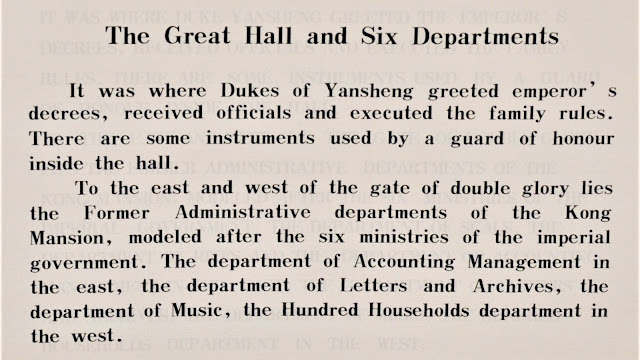
The great hall and six departments at Confucius Family Mansion (孔府).

The great hall and six departments at Confucius Family Mansion (孔府).

The great hall and six departments at Confucius Family Mansion (孔府).

The great hall and six departments at Confucius Family Mansion (孔府).

The Back Garden at Confucius Family Mansion (孔府).

Confucius Mansion covering 39 acres, has 463 buildings such as halls, pavilions, and towers that are divided into three parts. The Eastern part is the family temple, the Western institute and the Central main buildings. The Central part is then divided into two sections with the front being the office and the family residence behind. The garden is located at the back of the residence.

Confucius Mansion.

Confucius Mansion is built on an ‘interrupted’ north–south axis with administrative offices at the entrance (south) and private quarters at the back (north). The Ceremonial Gate (重光门, Chóngguāng Mén) was opened only when emperors dropped in. The central path passes a series of halls, including the Great Hall (大堂, Dà Táng) and Nèizhái Gate (内宅门, Nèizhái Mén), which separated the private and public parts of the residence and was guarded at all times.

Confucius Mansion Qianshang halls refer to seven rooms of the Mansion of Confucius, where the host received his relatives and bosom friends, and weddings and funerals took place. In the courtyard you are greeted by a luxuriant Aquilaria Sinensis. When it comes to the late spring and early summer, the white flowers scents the air. Four stone drums, laying on the large platform in front of the hall, used to be base of a stage on which theatrical troupe performed for the mansion. In the spacious Qianshang hall hangs a horizontal board inscribed with "宏开慈宇", and a Chinese character "寿" (literally meaning longevity) written by Empress Dowager Cixi (1861-1908).

Confucius Mansion Hall.

Confucius Mansion Back Garden (后花园) situated in the backyard of the residence, it is also called Tieshan Garden. However, there are no iron mountains but some iron ores resembling hills in the northwestern corner. The iron ores were transferred by Kong Qingrong in the Jiaqing Period (1796-1820) of Qing Dynasty, and from then on he called himself the master of Tieshan garden. The garden was built in the year of 1503 and renovated three times on a large scale.

The painting on the back wall of Confucius Mansion.

The painting on the back wall of Confucius Mansion.
Total expenses for day 11 is Y486 or RM243 per person
Day 01 (29.11.2011) AirAsia Kul - Hangzhou D7-306 17552225 hrs
Day 02 (30.11.2011) Hangzhou (West Lake walking)
Day 03 (01.12.2011) Hangzhou (West Lake cycling)
Day 04 (02.12.2011) Hangzhou by bus to Qiandao Lake (Thousand Island Lake)
Day 05 (03.12.2011) Qiandao Lake - ferry - Shendu - bus - Tunxi (Huangshan City)
Day 06 (04.12.2011) Tunxi (Huangshan City) - day trip to Mt.Huangshan
Day 07 (05.12.2011) Tunxi (Huangshan City) - day trip to Hongcun & Xidi
Day 08 (06.12.2011) Tunxi (Huangshan City) - by train to Nanjing
Day 09 (07.12.2011) Nanjing
Day 10 (08.12.2011) Nanjing by train to Taian (Shandong)
Day 11 (09.12.2011) Taian (Shandong) - day trip to Qufu
Day 12 (10.12.2011) Taian (Shandong) - day trip to Mt. Taishan
Day 13 (11.12.2011) Taian by train to Shanghai
Day 14 (12.12.2011) Shanghai - day trip to Suzhou
Day 15 (13.12.2011) Shanghai - day trip to The Bund
Day 16 (14.12.2011) Shanghai - day trip to Zhujiajiao the ancient water village
Day 17 (15.12.2011) Shanghai - Tian Zi Fang, Yuyuan garden & shopping
Day 18 (16.12.2011) Shanghai by train to Hangzhou AirAsia D7-303 to K Lumpur 14101910 hrs
///Backpacking to Shanghai 18 winter days in China 29 Nov - 16 Dec 2011
| EXPENSES | ..RMBY | . . . .RM | . .Total | Per pax |
| a. | Bus - Tianwu village for Mt. Taishan | 8.00 | 4 | ||||
| Day11 | b. | KFC - soya bean drinks | 24.00 | 12 | |||
| c. | Car rental - Tianwu to Qufu & back | 300.00 | 150 | ||||
| d. | Entrance fees - Confucius village | 240.00 | 120 | ||||
| e. | Confucius village guide fee | 40.00 | 20 | ||||
| f. | Surname calligraphy | 160.00 | 80 | ||||
| g. | Lunch in Qufu town | 299.00 | 150 | ||||
| h. | Entrance fees - Confucius temple | 200.00 | 100 | ||||
| i. | Entrance fees - Confucius mansions | 320.00 | 160 | ||||
| j. | Guide fees - temple & mansions | 100.00 | 50 | ||||
| k. | Room - Taishan IYH | 256.00 | 128 | ||||
| Y1,947 | Y486.75 |
///Backpacking to Shanghai 18 winter days in China 29 Nov - 16 Dec 2011

Ching,
ReplyDeleteNice portrayal of your 8-10th days of travel. I was in Nanjing few yrs back but couldn't bring myself to the War Museum which depicted the cruelty of the Rape of Nanjing by the invading Kempeitai Japanese Army. I would have broken down there and then just viewing the pics. A Chinese woman writer who was based in US, completed a detailed book on Japanese atrocities when incvading Nanjing. At the end of her exhaustive research and her toil, she couldn't take it anymore as she uncovered more inhuman incidents inflicted upon the Chinese during the war, she committed suicide. Apa nama? so sorry, I didn't jolt down. Guess I can google it.
It was a pity I didn't have the opportunity to visit the Ming Tombs as the tour guide was reluctant, telling us all programs had been arranged etc...
Regds from
Alan Kok, KL